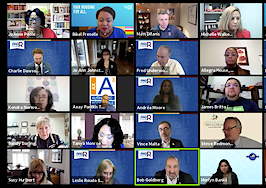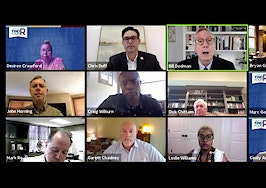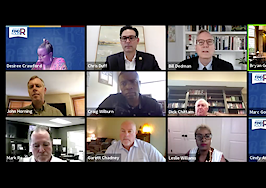The racial wealth gap is no accident. Policies at all levels of government, especially the federal government, for decades were specifically targeted to create the disparities.
They did this with the ready and willing help of Realtors. Closing the gap will take the same kind of precision and intentionality, even if that challenges what, in a vacuum, people think of as “fair,” according to speakers at the National Association of Realtors’ annual conference Tuesday.
M. Ryan Gorman, president and CEO of Coldwell Banker and Mehrsa Baradaran, professor of law at UC Irvine and author of How the Other Half Banks and The Color of Money: Black Banks and the Racial Wealth Gap, spoke at a session called “The Role of Homeownership in Advancing Racial Equality and Ending Racial Disparities” at the Regulatory Issues Forum of the Realtors Conference and Expo.
Much of the session was devoted to explaining the history of housing discrimination and roles played by the government and Realtors, in an effort to convince conference attendees that action was warranted.
“Well into the 1960s many Realtors were complicit in odious practices like redlining and enforcing racial covenants,” said Vince Malta, NAR’s president, who moderated the discussion.
“This racism was codified by the banking system and by official government policy. The legacy of this racism still looms large today. Housing discrimination and segregation have devastating impacts on families in terms of the racial homeownership gap, the racial wealth gap, disparities in education, health care, and so much more.”
Studies have shown that one’s ZIP code is a better indicator of life expectancy than one’s genetic code, Malta added, saying, “Realtors have a special responsibility to remedy this history” and “have honest and frank discussions about the disparities that exist because we can’t address problems we don’t see and we don’t measure.”
Baradaran noted that the racial wealth gap impacts vital aspects of people’s lives, including future income, exposure to violence, access to clean water, access to public infrastructure, access to parks, whether schools are underfunded or not, the kind of roads that run through a neighborhood, the kinds of police interactions people have and how much of a population ends up in prison.
‘George Floyd was shot in a redlined neighborhood’
In Northern cities, segregation was first enforced by violent mobs and real estate brokers, but then government-imposed redlining systematically decided who got to accumulate government-subsidized wealth, according to Baradaran.
“The neighborhood that George Floyd was shot in, that was a redlined neighborhood. You can track all of those maps. If you look at the racial dot map, if you look at the election map, you can map those right onto those red-lined maps. […] What that meant is you didn’t get an FHA [Federal Housing Administration]-guaranteed mortgage. You did not get, usually, a GI Bill. And what that amounted to is that you didn’t get to build intergenerational wealth,” Baradaran said.
Recipients of government-backed FHA loans were able to get 30-year fixed-rate mortgages and their neighborhoods saw rising equity, schools and parks funded by property taxes, and businesses coming in, according to Baradaran.
“The homeowners are increasing in value, the banks are doing quite well, and the government programs that started the guarantees are actually making profits as well. So it was a really great government program, except for the fact that it completely segregated the population into this century in a way that has become so cemented,” she said.
Redlined areas without FHA-guaranteed mortgage loans saw homes that did not increase in value. That meant that those neighborhoods were where cities decided to zone for industry, increasing environmental pollutants, and where they decided to run highways through whole black neighborhoods, she said.
Globalization meant there were fewer jobs, and then the War on Drugs came with the “over-criminalization of drug penalties,” Baradaran said, noting that the government is not dealing with opiates (which largely are associated with white people) the same way that it dealt with crack in the 1980s and 1990s.
‘We have to consider race’
Baradaran emphasized that she wasn’t talking about anyone’s personal animus against any race.
“I can assume that every person has good feelings towards all the races and this system will still self-perpetuate because this system is built on credit,” she said.
“You can do it with FICO scores. You don’t have to see the person anymore. You can have a computer algorithm that actually shoots out racially discriminatory outcomes because you can use literally any other factor at this point because of this history that we never fixed,” she said.
While the Fair Housing Act passed in 1968, it generated a major anti-integration backlash and subsequent Supreme Court decisions, including Regents of the University of California v. Bakke in 1978, that made it very difficult to consider race for anything other than diversity in education, according Baradaran. She noted that Chief Justice John Roberts had recently said that the way to stop discriminating based on race is to stop discriminating based on race.
“In other words, ‘we’re just going to colorblind racism away,’ and that doesn’t work. It hasn’t worked. Because it’s not about racism. It’s about housing values. It’s about appraisals. It’s about your FICO scores. It’s about who has schools in their neighborhood that are well-funded and who doesn’t. All those factors. We have to consider race if we’re going to fix those things,” she said.
‘Imprecise action doesn’t address the problem’
Gorman stressed that it’s important to understand how inequality became structural in order to decide which actions to take, but that those actions must be targeted. Earlier this year, Coldwell Banker launched its Inclusive Ownership Program, which is aimed at increasing the representation of minority, women, LGBTQ+ and veteran entrepreneurs at Coldwell Banker franchises.
“When the problem is precise, taking imprecise action doesn’t address the problem. Oftentimes, what’s happened when a problem has been recognized is people have said, ‘Yeah, you’re right, we really need broad homeownership programs for low-to-moderate income individuals.’ And it’s like, okay, well, that’s not what I said the problem was. I said the problem was pretty precise and you just mentioned a pretty broad program, which would be great to have, but it’s different than what I was really talking about,” Gorman said.
“I think there’s a discomfort with that,” he continued, as Baradaran nodded vigorously.
“There’s a political challenge with … being more precise, because frankly, if you’re a legislator up for election, you want to do things for as many constituents as you possibly can. Having conversations about thin slices of your constituent base don’t necessarily get you re-elected or get you re-supported for office.
“So the challenges are real, but … the challenges are also very narrow in some cases and what we do about it needs to be similarly narrow if we hope to make change.”
Target areas left out the first time
Opportunity zones and the Community Reinvestment Act are fine, but expecting the market, with tax inducements, to fix problems created with government policy isn’t going to work, Baradaran said, noting that both programs have been around for decades with the former called “Enterprise Zones” during the Clinton presidency.
What needs to be done is not complicated, though it may be difficult politically, according to Baradaran. She noted that Italian and Irish Americans used to not be considered white and therefore were ineligible for FHA loans and were bound by racial covenants excluding non-whites, but they were able to file court cases that declared them to be white, opening up those doors.
“How do we build wealth for Italian and Irish Americans? Just do that. Look at those FHA maps. Basically, they’re still intact. Look at those areas we left out the first time. Now, do it with those areas, whether it involves government guarantees, whether it involves down payment assistance or you can do the housing grants where you kind of break up those factors,” she said.
For instance, the Moving to Opportunity program from the U.S. Department of Housing & Urban Development (HUD) where families were provided with rental assistance to move from poverty-stricken neighborhoods to middle class ones was “very limited” in its scope, but successful, according Baradaran.
“Within one generation those kids have drastically different outcomes than the kids that had remained. These are controlled experiments that were done over time with really stunning results,” she said.
“We’re talking about kids at schools. There’s no magic to a middle class neighborhood, but it is about resources. It is about exposure to all the things that you know are not good for kids growing up like violence and instability and evictions, drugs, crime.”
‘Fair is a four-letter word’
This is not about anyone gaining at the expense of someone else, she emphasized.
“When Italians became included, when the Irish became included and gained wealth, nobody lost anything, right? It’s not like you have to take from somebody to give it to somebody else,” she said.
Rather, the racial wealth gap is costing everyone money, she added, noting that Citigroup had just published a study highlighting that the racial wealth gap has been a drag on the economy. That study found that if the U.S. had closed racial gaps for Black Americans in wages, housing, education and investment 20 years ago, $16 trillion could have been added to the U.S. economy.
According to Gorman, the word “fair” is a “four-letter word” when people think that a solution is disadvantaging one group to advantage another group, but he believes those who immerse themselves in the issue and take the time to read books or listen to podcasts about it will come away with “a very different understanding about what is fair.”
“Once we immerse ourselves in the history a little bit, I think it will feel different. I think it will resonate differently with people when some of these potential solutions are proposed,” he said.
He repeated the need to be precise, noting that businesses don’t just work around a problem.
“If someone said, ‘Hey I’m really looking to grow into this other market,’ and I proposed a million solutions that failed to even mention the name of that market, never spoke about that market, but instead said, ‘Well maybe we can design this approach and that approach and this marketing and that collateral,’ and you’d say, ‘What are you doing? I don’t have time for all that. I need to actually get into this market,’ we’d be much more precise,” he said.
“But it does require people to have an appreciation for how we got here, so that the path forward doesn’t feel unfair, doesn’t feel disadvantaging [to] anyone, it really feels righting a wrong, and it feels really blatantly obvious at times,” Gorman said.
‘Whose kid deserves that school, if not my kid?’
There’s not necessarily one silver bullet or one policy that will fix racial inequality, according to Gorman.
“It’s really a million little things. It’s taking place in every community in which we operate in, in town council meetings and zoning hearings and in discussions with builders and understanding that we don’t need everything to be at mass scale. It’s okay for some programs to only work in some places but still make a positive difference,” he said.
Baradaran pointed to a mindshift that needs to take place when it comes to race and housing, particularly in regards to schools.
“When you’re looking for a home and you say, ‘Well this is not a good school. You don’t want to send your kids to that school’, and then just asking: Well, whose kids should go to that school? Whose kid deserves that school, if not my kid?” she said.
“Those are the places where those kind of exclusion patterns end up implicating all of us when we choose where we live and when we steer certain families to certain places.”
She cited a book, Dream Hoarders, about how the top 20 percent in American society practices “opportunity hoarding” for their children when it comes to academics and sports programs as well as other “perks.” There’s an idea that some kids are “our kids” and some kids are “those kids” in a community, according to Baradaran.
“All those kids are our kids. They’re not those kids, for those families — these are all our kids. We just need to draw out the parameters of our community,” she said.
“It cannot be ‘I don’t want those kids coming into my kids’ school.’ That I think is a place where we all have seen and heard racism propagate because you know what you mean by ‘those kids’ and even if you’re saying, ‘I have nothing against, not even thinking about racially,’ it just turns out to be that those kids are black or brown kids.”













